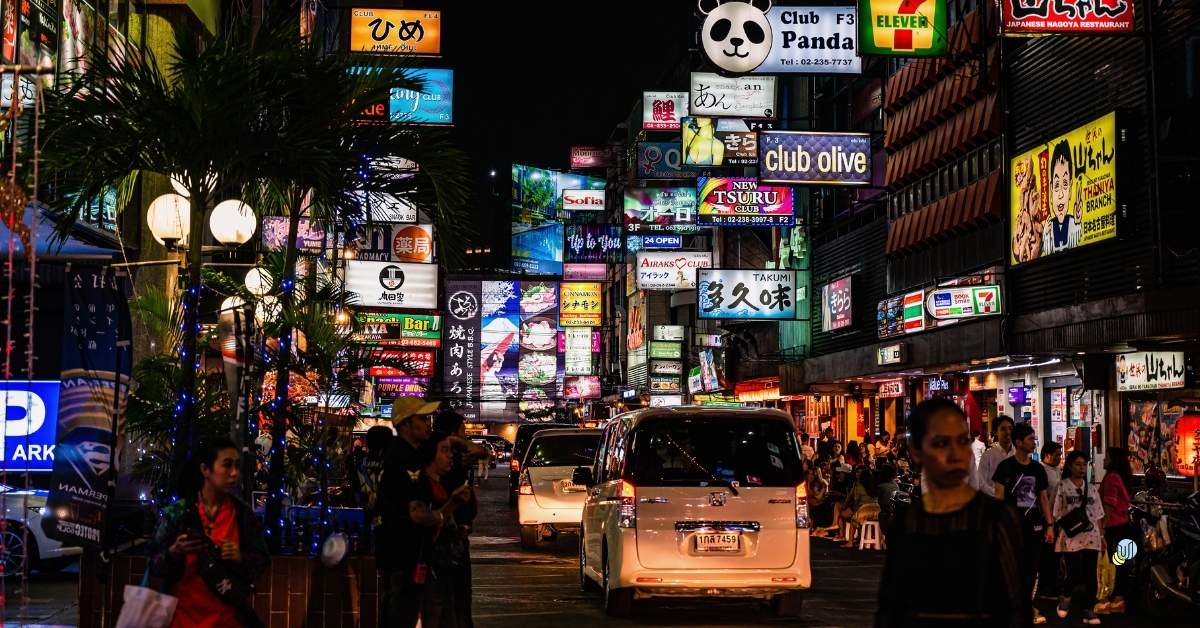It is estimated that the sex industry in Thailand is worth 6.4 billion US$ a year. According to the government, 200,000 people work as prostitutes, but numbers on prostitution are controversial as it is an underground industry. NGOs are talking about much higher figures: around 2.8 million people are thought to be involved in this industry: 2 million women, 20,000 men, and 800,000 minors.
These figures include the prostitutes themselves, but also the other workers at places where prostitution occurs, as well as the corrupt police. Plus, many more people depend on the money sent home by the prostitutes to their families, mostly in the countryside.
Prostitution did not appear recently in Thailand. The arrival of many US soldiers in the 50’s is commonly considered the beginning of a large-scale industry, but it did not create the phenomenon. It did make it dramatically increase.
Also Read
During the Ayutthaya period (1350 – 1767), there were even state run brothels, and prostitution was legal until 1960. In Thailand, prostitution takes place quite openly, and even if prostitution is not accepted by society as a whole, it is common throughout Thailand and to some extent, accepted.
The evolution towards a large scale industry
In the 50’s and 60’s, the US military started to station troops in Thailand. Indeed, Thailand is close to Vietnam, and the US had concerns about the spread of communism in the region.
Many soldiers fighting in Vietnam were also sent to Thailand for rest and recreation. In the 60’s there were almost 50,000 troops stationed around Bangkok. Many soldiers with a relatively high income were looking for prostitutes. This was the beginning of an actual industry.
By agreeing to the militarization of the country, Thailand benefitted from direct aid and from the money spent by soldiers on rest and recreation, which included commercial sex. Thai leaders tolerated this behavior, but were never coerced into supporting the sex industry. The presence of the US troops created an opportunity to increase the scale of the sex industry. Even though the troops were in Thailand for less than a decade, it changed the scope of commercial sex tremendously.
In 1960, the international community put pressure on Thailand to act against human trafficking in the sex industry. The parliament thus passed a law, making prostitution illegal: the Prostitution Suppression Act, even though prostitution was taking place quite openly. With this law, only the prostitutes were held accountable.
In 1966, the Service Establishment Act allowed some businesses to offer “special services” which were not explicitly sexual. Such as massage parlors where the customers can chose their masseuse through a glass door, or bars where girls are payed only to serve the clients and chat with them. Other “special services” occurred at bathhouses, karaoke, etc. The fact that sexual services are occurring is a barely hidden secret, but the establishments are licensed and sexual services are not supposed to be their primary activity. This law is still in place today, despite the common knowledge that these businesses are in fact, hidden brothels.
Therefore, in the 60’s, prostitution was rendered illegal but “special establishments” were authorized, which weakened the autonomy of the prostitutes whom could no longer work independently.
At that point, the World Bank started promoting tourism as a way for Thailand to pay for development. In the 70’s, sex tourists replaced soldiers as the main foreign customers. Neither the World Bank nor the Thai government ever directly promoted sex tourism, however western visitors had already made the association of Thailand and prostitution.
It is to be noted that most clients are Thai men: more than 70% of Thai men have had their first sexual experiences with prostitutes. It is a common form of recreation among men in Thailand. The foreign influence allowed for this industry to get to this scale, but the industry is mostly supported by Thai men.
Later in 1966, The Prevention and Suppression of Prostitution Act replaced the Prostitution Suppression Act of 1960. Under this new law, customers, establishment owners and parents involved in child prostitution were facing fines and incarceration. Before that, only the prostitutes themselves were held responsible. With this law, still in place today, clients are criminalized as well as prostitutes. This also applies to anyone who is recruiting, involving minors or associating at the location of the prostitution.
A symptom of a much larger issue
In the 60’s, Thailand began what was later referred to as an economic miracle. With such a fast development, the country shifted from a rice-exporting agrarian country to a highly industrialized nation, and became one of Southeast Asia’s tiger economies. But this economic miracle was largely turned towards urban centers, leaving rural areas completely cut off from economic growth. This development created an increase in inequalities between cities and countryside areas. Indeed, large parts of the population were excluded from the benefits of the development.
Rural women are traditionally considered crucial economic agents. But in the development policies, there was a big difference between the expectations falling on women and the opportunities they could actually find.
There are big expectations on women to provide for their family and they are expected to be breadwinners. But the lack of qualifications and opportunities available are making this status very difficult for them to achieve. The women’s role has thus evolved to include sex work as a legitimate path. As a matter of fact, most sex workers are uneducated women from rural areas. The rapid development of Thailand has increased salaries for middle and upper class men allowing more money to be allocated to the sex industry.
Thailand’s development strategy has never relied on sex work explicitly, but it is safe to say that it became an integral part of the economy. Sex workers remit most of their money to their family, which allowed consumerism to appear in disadvantaged communities of rural Thailand. Most women in this industry are from rural areas and they send most of their money back to their family. A large portion of the population has an economic dependency on sex work.
Prostitution thus allows for some financial re-distribution to the rural areas. It is well known that the remittance sent by sex workers to their families exceeds the amount allocated by the government to development projects in the countryside. Sex work thus appears to mitigate development policies that leave rural areas behind.
In 1998, the industry had grown so much that it became an integral part of Thailand’s economy. Without explicitly calling for a legalization of prostitution, the International Labor Organization (ILO) recommended Thailand to recognize it as an economic sector and an income generator. Indeed, according to ILO, sex work represents from 2 to 14% of the country’s GDP. The revenues coming from the sex industry are crucial to millions of workers beyond the prostitutes themselves, like all the rest of the staff working in the “special establishments”. Recognizing such work would allow the government to get substantial revenues from licenses and taxes.
Furthermore, the ILO recommends separating measures addressed to victims of human trafficking and women who have entered the market for pragmatic reasons. For the latter, giving them access to labor law seems like the priority. Indeed, 85% of sex workers are employed in legally registered establishments. Working there isn’t illegal, so the workers should be under the protection of Thai legislation. But the government does not enforce these laws for them and they don’t get labor protection or benefits as they are violating the prostitution law.
Government hypocrisy
Today, the government wants to change the image of Thailand and mentions the “moral fabric” of the country in its attempt to abolish prostitution. However, this is a difficult position to hold considering the immense revenues generated by the industry. Authorities are using morality to announce the end of prostitution in Thailand. But so far, apart from some highly mediatized police interventions, the government’s position is not much more than words. There are even reports from the police that there is “no such thing as prostitution”, denying the obvious. Laws are in place to prevent prostitution, but the nation has always relied heavily on punishment as a deterrent instead of addressing the structural causes of the exploitation women and young girls, such as the lack of labor law enforcement, poverty, unemployment, citizenship status, and traditional gender roles.
Once women have been identified as victims of human trafficking, they are detained in government shelters, where they can’t have any contact with their family. The sensationalist reporting made by the government and the entrapment methods allowing the arrests are violating the dignity of women. In government shelters, women can have access to vocational training: for jobs based on gender stereotypes (sowing, domestic jobs, etc.) which are very low paying, plus they get no support once they get out.
This issue is even harder to address as it relies heavily on corruption. This industry could not exist without the complicity of the local police who knowingly take bribes from establishment owners so they can remain open. If the government appears to be making some efforts in addressing this issue, the corruption and official complicity remains an obstacle to anti-trafficking efforts.
In 2003, the government opened a public debate on the legalization of prostitution. The Justice Ministry had proposed a law to legalize prostitution. Eventually it was not passed, but it created an open debate on the issue and seems a good first step in order to find a more appropriate solution.
Michigan Feminist Studies – Rethinking the Sex Industry: Thailand’s Sex Workers, the State, and Changing Cultures of Consumption –Dulcey Simpkins – vol. 12, 1997-1998 – Issue title: Unequal Exchange: Gender and Economies of Power – https://quod.lib.umich.edu/cgi/t/text/text-idx?cc=mfsfront;c=mfs;c=mfsfront;idno=ark5583.0012.005;rgn=main;view=text;xc=1;g=mfsg
International Labor Organization – Sex Industry Assuming Massive proportions in South East Asia –August 1998 – http://www.ilo.org/global/about-the-ilo/newsroom/news/WCMS_007994/lang–en/index.htm
Empower report submitted to CEDAW – Sex workers and the Thai entertainment Industry –July 2017-http://tbinternet.ohchr.org/Treaties/CEDAW/Shared%20Documents/THA/INT_CEDAW_NGO_THA_27511_E.pdf
Le Point – Thaïlande : la fin de la prostitution à Pattaya, un vœu pieux – Avril 2017 – http://www.lepoint.fr/monde/thailande-la-fin-de-la-prostitution-a-pattaya-un-voeu-pieux-18-04-2017-2120445_24.php
Bangkok Post – No sex please, we’re Thai – Chaiyot Yongcharoenchai – février 2017 – https://www.pressreader.com/thailand/bangkok-post/20170226/282815011019300
The Age – Thailand mauls legal prostitution – November 2003 http://www.theage.com.au/articles/2003/11/26/1069825832486.html?oneclick=true













